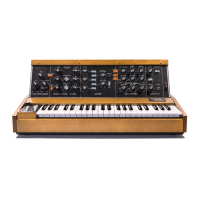11 | Getting Started
Begin by carefully removing your new Minimoog Model D from its packaging. It’s
recommended that you save all original packing material, should you ever need to
safely move or ship the instrument. In addition to the instrument itself, Minimoog
Model D also includes this owner’s manual, a power adapter, and the connecting
power cord.
SETUP & CONNECTIONS
The front panel of Minimoog Model D is hinged, so use caution and avoid grasping the
top of the panel when lifting or moving the instrument.
Place Minimoog Model D on a stable surface, such as a table or keyboard stand. Be
sure the instrument is placed at a comfortable playing height. The front panel can
remain flat, or it can be tilted to a convenient angle for accessing the controls.
To get started, you will need to supply Minimoog Model D with power and connect it
to an audio monitoring system, or listen using a set of headphones.
AC POWER
Minimoog Model D uses a universal power supply that can operate using AC power
sources ranging from 100 to 240 volts at either 50 or 60 cycles (Hz). The included
power supply features a detachable IEC-style power cable.
1. Connect the included IEC power cable to the Minimoog Model D power supply.
2. Connect the power supply cable to the Minimoog Model D locking XLR-4 connector.
3. Connect the other end of the power cable to a suitable AC wall outlet.
4. Finally, use the POWER switch to turn on your new Minimoog Model D.
NOTE: The power supply connects to the Minimoog Model D using a locking connector. To
release this connector from the instrument, simply press the locking tab at the base of the
connector and gently pull up on the connector plug. Do not pull on the cable itself.
RAISING THE PANEL
1. Grab the front panel by the top wood edge and tilt it forward toward the keyboard.
2. Flip up the hinged metal kickstand located in the area under the rear panel.
3. Position the top edge of this kickstand against one of the four screw heads
protruding slightly from the rear of the panel. (Each screw head will support the
panel at a dierent angle.)
4. To lower the panel, again tilt the panel forward until the hinged kickstand returns to
its original position, then gently lower it.
Getting Started

